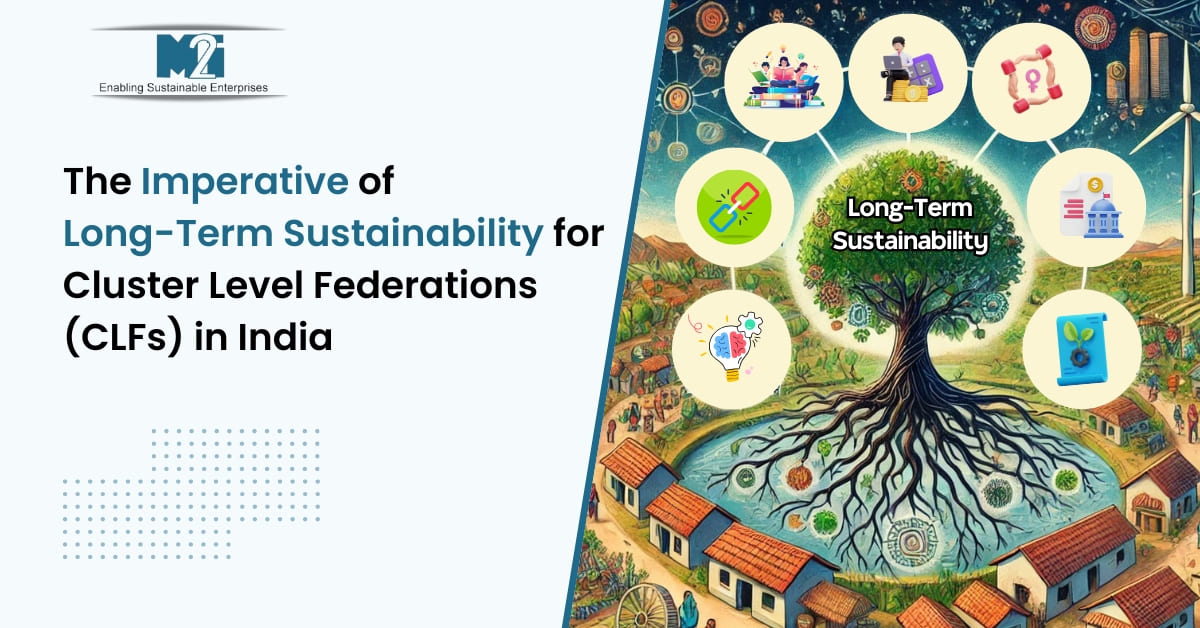
The Imperative of Long-Term Sustainability for Cluster Level Federations (CLFs) in India
Cluster Level Federations (CLFs) are critical institutions within India’s rural development framework, uniting Self-Help Groups (SHGs) and supporting women’s economic empowerment and community development. Established as collective entities, CLFs provide resources, training, and financial assistance to SHGs, helping them thrive and promoting financial inclusion in rural communities. As CLFs grow in importance, ensuring their long-term sustainability is essential to secure lasting socio-economic benefits for their members and, by extension, for entire communities.Why Long-Term Sustainability Matters
1. Consistent Economic Empowerment
CLFs play a crucial role in facilitating economic empowerment by providing women with access to credit, financial literacy, and skills training. Sustained support from CLFs enables SHG members to establish and grow businesses, enhancing their income levels and fostering self-sufficiency. Without the long-term presence of CLFs, many SHGs risk losing these essential resources, which could diminish their ability to maintain or expand income-generating activities.
2. Stability in Financial Inclusion
CLFs contribute significantly to India’s financial inclusion efforts, bringing financial services closer to rural communities where access to traditional banking remains limited. By ensuring the continuity of CLFs, rural communities can experience consistent access to microloans, savings options, and investment guidance. This long-term presence is crucial for preventing financial exclusion and encouraging responsible borrowing and saving practices within rural areas.
3. Strengthening Local Economies
The economic activities driven by SHGs supported by CLFs often lead to growth in local economies, creating jobs, increasing spending, and stimulating demand for local goods and services. With sustained CLF support, SHGs can continue to generate revenue within these communities, creating a positive economic cycle that benefits both SHG members and the local population. Long-term sustainability is essential for maintaining this economic momentum and ensuring that CLF-supported initiatives contribute to broader regional development.
Challenges to Long-Term Sustainability
1. Dependence on External Funding
Many CLFs rely on government grants or donor funding to operate, which can fluctuate based on policy changes or shifting priorities of funding agencies. This reliance on external support creates a vulnerability, as any reduction or withdrawal of funding can disrupt services and hinder the ability of CLFs to fulfill their mission. Building financial self-sufficiency is therefore critical to achieving sustainability.
2. Management and Operational Challenges
CLFs often face challenges related to governance, operational efficiency, and leadership continuity. Effective management requires skilled personnel, sound organizational practices, and clear structures for decision-making, which may be lacking in some federations. Addressing these operational challenges is vital to ensure CLFs are resilient, adaptable, and capable of achieving their goals sustainably.
3. Changing Needs of SHG Members
As rural economies and markets evolve, the needs of SHG members may shift. CLFs must be equipped to adapt to these changes by expanding the range of services offered, updating training programs, and introducing new financial products that align with emerging economic opportunities. Long-term sustainability requires CLFs to be dynamic organizations that can respond effectively to the changing landscape of rural development.
Strategies for Ensuring Long-Term Sustainability of CLFs
1. Promoting Financial Self-Sufficiency
For CLFs to achieve long-term sustainability, they need to develop financial self-sufficiency. This could involve generating revenue through membership fees, service charges, or by establishing partnerships with local businesses. CLFs could also consider setting up income-generating initiatives, such as producing and selling value-added products made by SHG members. These activities could reduce dependence on external funding and provide a stable source of income for ongoing operations.
2. Capacity Building and Leadership Development
Strengthening the management and leadership capabilities of CLFs is crucial for their sustainability. Providing training for CLF leaders in areas like financial management, governance, and strategic planning can help federations become more effective in fulfilling their mission. Leadership development programs can also help ensure continuity in governance, preparing the next generation of leaders who can carry forward the CLF’s work effectively.
3. Encouraging Digital Transformation
Digital tools can enhance the efficiency and reach of CLF services. Implementing digital platforms for financial transactions, record-keeping, and communication can improve transparency, reduce operational costs, and make it easier for CLFs to serve a larger number of SHGs. Digital literacy training for members and leaders can further enable CLFs to utilize technology effectively, positioning them as modern, resilient institutions in an increasingly digital economy.
4. Forging Partnerships with Government and Private Sector
Establishing partnerships with government agencies, banks, and private sector organizations can help CLFs access resources, gain expertise, and expand their impact. Such partnerships can offer CLFs access to grants, technical assistance, and market linkages, which can support both the federation’s operations and the economic activities of SHG members. Strategic partnerships also offer CLFs an opportunity to diversify their support base, furthering their long-term resilience.
Diversifying Services and Adapting to Market Needs
Long-term sustainability requires CLFs to stay relevant to the evolving needs of SHGs. Expanding the range of services to include vocational training, digital financial services, and access to e-commerce platforms can help SHG members access new economic opportunities. This diversification enables CLFs to provide greater value to their members, increasing their importance within communities and justifying continued investment in their activities.